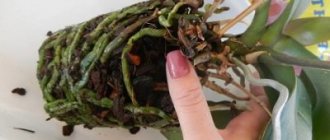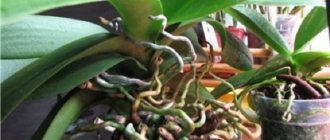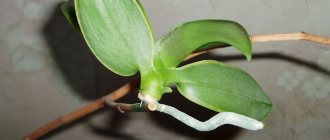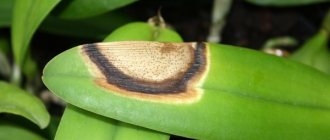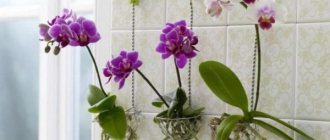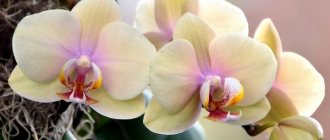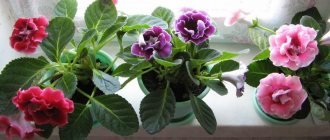Multi-flowered hybrids, or multiflora, differ significantly from the classic phalaenopsis. An adult plant looks like an airy cloud of flowers.
This living bouquet is formed by several highly branched peduncles, which continue to grow and produce new buds right during flowering! The color palette of these green beauties is very diverse and includes pink, coral, peach and, of course, white colors in many combinations. The petals are dense and waxy.
Description
First, let's figure out what multiflora means. By this name, botanists understand a large group of phalaenopsis hybrids.
The name of such a plant consists of several words, for example “Phalaenopsis Multiflora Sakura Pink”. The first two indicate belonging to the “multiflora” trait, followed by the name of the hybrid.
Particularly valued are those whose markings say: “FCC First Class Certified .
Problems with growing Multiflora orchids
During plant growth, unforeseen circumstances may arise, the cause of which is various diseases. It is important to promptly identify the first signs of flower disease and take measures to preserve it.
After purchase, it is worth inspecting the plant for various types of damage to the roots and leaves. Multiflora most often affects:
- spider mite - it forms holes in the leaves and drinks the plant sap through them. To get rid of this pest, you should spray the flower with a special insecticide or onion decoction and wait 15 minutes. Then wipe the leaves with cotton wool;
Spider mite
- moldy rot and mold - damaged areas should be cut with scissors or garden pruners, the cut areas should be greased with ash, and the remaining healthy areas should be treated with Fundazol. But you shouldn’t get carried away with this procedure too often;
- fungal infections - if such damage is detected, you need to transplant the orchid into another soil, a new pot and lubricate the leaves of the flower with an antifungal agent sold in a specialized store.
The best prevention of any undesirable situation with a flower is responsible adherence to all care tips. If you follow the instructions, then difficulties in growing this type of flower, as a rule, do not arise. The main thing is to do everything carefully, correctly and systematically.
It will also be interesting: Wild Cat Orchid - description and care at home?
Most popular types
Now that we know what it is - a multiflora orchid, we present its most popular varieties:
- Multiflora white (Phalaenopsis Multiflora white);
- Multiflora purple (Phalaenopsis Multiflora purple);
- Phalaenopsis Multiflora Sannion;
- Santos;
- Black night.
Multiflora white.
Multiflora violet.
Multiflora Sannion.
Santos.
Black night.
Varieties with name, description and photo
The Phalaenopsis Multiflora species includes about 70 varieties - both popular and rare. Let's look at the most common varieties.
White
Multiflora white. The flowers are white without shades of other colors or inclusions, but have a yellow core. The shape resembles very small water lilies.
Read about other white phalaenopsis here.
Purple
Multiflora purple. The flowers are relatively large. The petals are lilac: dark at the edges, lighter towards the middle. They shimmer slightly in the light, as if covered with white wax.
Mirage
Mirage. It belongs to the variety of midi orchids, when there are not as many buds on the peduncle as on a regular multiflora. The flowers are an interesting brick shade with small inclusions. The lip is a plain crimson color.
Sanion
Sanion. White or pale pink petals covered with purple specks. The heartwood is yellow-purple.
Externally and in terms of botanical characteristics, it resembles the Wild Cat and Cleopatra varieties, which is why they are often confused.
Santos
Santos. White or pale pink flowers are arranged in a crowded arrangement. The cores are voluminous and yellowish.
Soft Cloud
The peduncles are covered with identical white flowers with yellow cores. The inflorescence looks quite uniform and rustic, resembling a cloud in shape.
Schiller
On Phalaenopsis schilleriana, up to 100 fragrant soft pink buds can bloom simultaneously. What else is so interesting about this variety and its hybrids can be found here.
The Dragon
Dragon. Bright yellow petals, closer to the core, slightly carelessly covered with pink specks. The core is white-pink, voluminous.
What other popular phalaenopsis varieties are sunny in color? Read here.
Brown Sugar
The flowers are red-wine in color, but have a snow-white edge. Average size for the variety.
Cx322
Sometimes it can be found under the name Chameleon or Rembrandt. The petals are light pink with crimson splashes. If the inclusions are dense enough, the flowers appear darker.
Black night
Black night, but can also be found under a different name. The flowers are purple or dark purple, but the center and edges of the petals are pure white, creating an interesting contrast. It is distinguished by the triangular shape of its petals.
Midi (Venice)
Unlike other representatives of the Multiflora species, there are not so many flowers on the inflorescence, and they are somewhat larger. The petals are white and wide, the core is yellow, not clearly expressed.
External characteristics
An adult plant in full bloom has 4-6 large, shiny leaves up to 40 cm long . Some varieties - up to 12 pieces.
The maximum length of the peduncle under ideal conditions reaches 60 cm . This is a branched raceme with many flowers and buds that is constantly growing.
The shape of the flower corolla in most multiflora hybrids resembles the classic flower of a standard phalaenopsis, the diameter of which is much smaller - on average 2-3 cm, up to a maximum of 6 cm.
Photo of phalaenopsis multiflora flowers.
This group of hybrids can be painted in all colors possible for orchids. The most common color groups:
- white;
- pink and all shades of lilac;
- yellow, golden, peach, coral;
- coral, red.
Options for color combinations can be very diverse.
Prevention
In order to prevent an orchid from developing diseases or pest attacks, you need to follow several rules :
- properly care for the plant;
- fertilize from time to time;
- do not take the orchid out into the open air, so as not to attract the attention of pests;
- Once a week, wash off the dust from the leaves with warm water and spray the plant.
Phalaenopsis Multiflora orchid feels great at home. The main thing is not to forget to follow measures to care for the plant and take into account the characteristics of its species. Then the orchid will serve you for many years and will delight you with beautiful flowering.
If you find an error, please select a piece of text and press Ctrl+Enter.
Main features of flowering
Long, abundant flowering is achieved due to the continuous growth of the peduncle and the formation of new branches and fresh buds on them.
The peduncle is constantly growing , and therefore the time from the opening of the first bud to the complete shedding of flowers is quite long.
Several branches may appear at the same time, they begin and end flowering at different times, and it may seem that the orchid blooms all year round.
Interesting! News for those who have not encountered this variety of phalaenopsis before may be peduncles growing from somewhere deep in the root system. In hybrids belonging to the standard group, flower arrows appear in the axils of the leaves. Three or four flower stalks growing directly from the ground look very unusual.
Differences from other types of orchids
Multiflora belongs to the average phalaenopsis . It often grows 5-6 rich green leaves. A distinctive feature of multiflora is the withering of old leaf blades during the beginning of the growth of young leaves.
Another characteristic feature is the absence of a growth point. This indicates that the leaves are coming straight out of the soil. Flower arrows are also not simple - they have the ability to branch during flowering, forming many shoots with buds.
Landing
Despite the differences in appearance and flowering method, phalaenopsis hybrids have similar requirements for planting and growing.
Priming
The main component of the soil is pine bark. You cannot use fresh bark because it contains a lot of essential oils foreign to orchids. This cheap natural material must be boiled for several hours.
ready-made soil at a flower shop.
Pine bark is the main component of the soil.
Optimal capacity
Choose any transparent pot to suit your taste. The main selection criteria are that the walls of the container must transmit light, and the bottom must have holes to drain excess water. The volume must freely accommodate the root system. It is better to take a pot a little larger than the previous one.
Peculiarities
It is important not to injure the roots . They look thick and strong, but break easily. The soil around the plant must be carefully compacted. You should fill the soil with water two days in advance so that it is saturated, and rinse it before planting.
Diseases and pests
After purchasing an orchid, you should immediately carefully examine it for the presence of pests and diseases.
- Spider mite . They pierce the leaves of the plant and suck the juice from them. To get rid of these pests, you need to soak the flower for a quarter of an hour in an insecticide.
- Various rots . The affected areas should be removed, the cut areas should be sprinkled with cinnamon, and the healthy plant should be treated with foundation. But you should not get carried away with such a procedure.
- Fungal infections . If such a disease is detected, you need to transplant the orchid into new soil and treat the flower with any antifungal agent, strictly following the instructions.
We recommend watching a video about pests and diseases of orchids:
Home care
Optimal conditions of detention
The hybrid was bred for growing in a living room; there is no need to create greenhouse conditions . The light should be bright, but diffused - this is exactly the kind of lighting in the depths of the tropical jungle, in the homeland of orchids.
It is necessary to protect the green sissy from sunburn in the summer, and from freezing on a cold windowsill in the winter.
The plant should be kept clean, protected from dust and occasionally sprayed . The optimal temperature is + 22°C, with a nighttime decrease of 5-10°C.
The first flower shoots appear when the plant has fully developed and gained strength. Signs of early flowering may include:
- the plant is at least two years old;
- the leaves look fresh and elastic, the color is bright and rich, there are at least four of them;
- roots are clean and healthy;
The time of year doesn't really matter.
Replanting after shopping in a store
Important! Replanting a blooming orchid will only cause harm to the plant. Wait for the transition to the rest period.
Transplantation is needed mainly in order to examine the root system of the plant . To preserve moisture, pieces of sponge and sphagnum moss are placed among the roots - these materials must be carefully selected and removed from the roots. They have already played their role in transporting and preserving moisture and can only cause harm due to the formation of mold.
It is necessary to remove diseased roots. Black, brown areas, as well as dried ones, are cut off with a sharp, clean knife to living green tissue, the cut is sprinkled with crushed coal (can be activated from a first aid kit).
A transparent pot is filled up to a third of its volume with soil for orchids, then the plant is carefully placed and the rest of the pot is gradually filled with soil. The soil should “hold” the flower , preventing it from loosening in the pot.
Phalaenopsis transplant.
During the industrial cultivation of plants, they are intensively fed and stimulated to grow and flower. After purchase, you need to continue regular fertilization, otherwise the plant will “starve” and may even drop its buds.
Flowering time and dormant period at home
One of the distinctive features of this type of phalaenopsis is the absence of a pronounced dormant period and the ability to bloom almost all year round.
Watering and fertilizing
Water for irrigation should be of good quality, at room temperature. Let's water it with warm water.
Liquid complex fertilizer for orchids is dissolved in water for irrigation and the pot is immersed in a container with water for -2 minutes. Water should flow freely from the roots to avoid root rot.
Stimulating flowering
Such a common method as stimulating dormant buds in phalaenopsis with cetokininic acid is useless with multiflora, since this paste is applied to dormant buds. And the flower buds of these hybrids are located among the root system and are inaccessible for applying the paste.
To stimulate flowering, the only available methods are the general improvement of the plant, including the use of fertilizers. Succinic acid and epin are suitable.
Pruning after flowering
After flowering has finished, it is necessary to trim the branch above the second flower bud. If the plant is well developed, perhaps after a period of rest a new peduncle will grow from this bud.
Prevention of diseases and pests
In order for the plant to remain healthy, you need to create the most comfortable living conditions for it. To prevent diseases and pests, new plants brought into the house are quarantined for the first month. Never take an orchid to an open balcony , as you can easily pick up some living creatures there.
Attention! Multi-flowered hybrids develop powerful peduncles, abundantly dotted with flowers. This flower mass can be quite heavy. If the pot is too small and light, the orchid may fall and be seriously damaged. This is a serious argument in favor of a glass pot.
Recommendations for cultivation
Selecting a location
When choosing a place for an orchid, you should give preference to bright and well-ventilated areas. But ventilation should not turn into drafts. Just like lighting should not turn into burning. During hot hours, it is better to hide Multiflora from the sun . To do this, you just need to curtain the windows at this time.
Important : You should also beware of areas of the premises near heating devices, as they dry out the air and soil very much.
Preparing the soil and pot
It is better to purchase ready-made soil in specialized stores . It should be intended specifically for Orchids.
To prepare the substrate at home, you need to take pine bark, charcoal and sphagnum moss in equal proportions and mix it all. Don't forget about the drainage layer. This will ensure good air circulation in the flowerpot.
As for the pot, firstly it should be transparent, and secondly smooth. Transparency is necessary so that light penetrates to the roots, which take part in photosynthesis along with the leaves. The pot should be smooth in order to prevent roots from growing into the walls of the container.
Temperature
Multiflora refers to heat-loving plants . Therefore, the room temperature must be maintained at 23-26 degrees Celsius during the day. At night, the air may become cooler - about 18 degrees. But it is important to ensure that the temperature does not drop below this mark.
Humidity
Proper care of Multiflora is to maintain air humidity levels within 50-70%. On cloudy and rainy days, it is necessary to ventilate the room to avoid moisture stagnation.
On hot days, on the contrary, humidify both the air around and the orchid itself as often as possible. This can be done by simple spraying, as well as by placing a container of water near the flowerpot.
Lighting
We have already said that all phalaenopsis must be provided with plenty of light . In winter, additional lighting will be needed to increase daylight hours to 12 hours.
Watering
This can be done in two ways: under the shower and immersion. In the first case, not only the soil, but also the entire surface of the plant will be moistened. In addition, this is an excellent hygienic procedure - during a shower, all accumulated dust is washed off.
You need to immerse the flower in water for 30-40 minutes . Try not to overstay the specified time.
Tip : To understand that it’s time to water Multiflora, you need to carefully monitor the substrate. Once it has completely dried out, you need to wait a couple more days and only then moisten the soil again.
Top dressing
It is recommended to fertilize the orchid along with watering. This way the nutrients are distributed correctly and reach all parts of the plant.
It is best to purchase ready-made complexes for such flowers. It is important that everything in fertilizers is balanced . Especially nitrogen, potassium and phosphorus.
We recommend watching a video about proper feeding of orchids:
Transfer
This procedure needs to be carried out every 2 years. Pots should not be much larger than the volume of the root system. It is better to purchase ready-made substrate. We must not forget about drainage. The rhizomes should feel free in the flowerpot, so do not compact the soil too much.
Experienced gardeners recommend replanting an orchid without removing it from the old soil . It is enough to simply change the pot to a larger one.
Increasingly, gardeners are choosing phalaenopsis for home breeding. Among the most popular varieties are the delicate Liodoro, the elegant beauty Big Lip, the fragrant flower Wild Cat and the lovely Mix subvarieties.
Reproduction methods
At home, only vegetative propagation methods are suitable for propagating multi-orchids:
- plant a baby that can form on a peduncle or grow directly from a dormant bud of the root system;
- plant the plant that has formed several stems in different pots;
- cut and root the top with several leaves. The parent plant will also recover over time.
Propagation by seeds is not available in a living room. Firstly, the seeds are small, like dust. They form on flowers all the time, but we don’t even notice them. Secondly, their germination requires a special microclimate. Therefore, you should not buy orchid seeds, no matter what miracles the seller promises.
The main obstacle is that unusual and beautiful hybrids do not pass on their properties to their descendants . A baby that grows directly on a plant will inherit the color and shape of the flowers because it has the same set of genes.
Recommendations for stimulating orchid flowering
It happens like this: you bought Microflora, but it doesn’t bloom. Why? What to do? There are some simple recommendations:
- The plant may simply still be young. Different species begin to bloom at the age of 1 to 3 years; an adult specimen must have at least 5 shoots.
- Stop moving the pot from place to place: sissies with hanging roots do not like this.
- You can feed it with succinic acid.
- You can try adding a fertilizer high in potassium and phosphorus.
- Sometimes the reason lies in the content being too comfortable. Move the pot to a cool place and stop spraying your pet, then it will quickly become active.
It remains to add that growing such indoor flowers is not a very difficult task. But they really decorate any room.
4.5 / 5 ( 2 voices)
What it is?
For beginners who plan to breed orchids at home, a name such as multiflora orchid may raise a lot of questions, since even with minimal knowledge about this tropical crop, one classic name is familiar - phalaenopsis. In fact, phalaenopsis only designates a genus of plant, and based on the principle of flowering, orchids are classified into several groups.
- A standard type of vine that stands out for its rather large flowers. A feature of orchids of this group is the complete death of the apical bud on the shoot immediately after the end of the flowering phase.
- Phalaenopsis novelty - this crop will have smaller flowers, and the outermost bud will grow.
- Multiflora - the flower will have medium-sized flowers, as well as an upper bud, which will retain its vital activity during the flowering of the plant.
Multiflora stands out for its color variability, so the flowers of a hybrid can have the most incredible colors. In addition, orchids of this variety are able to shoot arrows directly from the ground and several at a time, without becoming attached to the growth bud of the mother crop. As for the flower stalks, throughout the entire flowering period they can grow and branch, while forming new fancy shoots with flowers.
In indoor conditions, multiflora has a rather modest size. As a rule, an adult plant does not exceed half a meter in height; the rosette of green mass has from 5 to 8 long leaves, which will have an oval shape. The leaf length can reach up to 30 centimeters.
After the plant has a young leaf at the top, the lower one dies. In the flowering phase, the crop can throw out from one to six arrows, on which peduncles will develop oppositely. The size of the flowers varies between 2-5 centimeters with a dense arrangement next to each other. As a result, a beautiful and flowering plant will appear on the windowsill or veranda, resembling a small bush in its splendor. Some orchids can have about fifty flowers blooming at the same time. Due to such features, the shoots of the crop must be supported and fixed in the middle and at the top. Multiflora is in great demand among flower growers, in light of which new hybrids with incredible flower colors regularly appear on sale.
According to the description of this variety, flowering with proper care can last from two months to six months. This duration is largely due to the order in which the flowers bloom. An orchid can bloom indoors, regardless of the time of year. Today there are several effective ways to achieve flowering by waking the crop from sleep if necessary.
Terms and rules of transplantation
Typically, this procedure is carried out for purchased plants approximately three weeks after quarantine, since it is not recommended to keep the flower in a store-bought substrate for a long time. It is treated with special preparations that support the decorative appearance of the orchid, but do not in any way stimulate its further growth and development.
Replanting is also necessary to inspect the root system in case of damage by diseases, pests, or rotting from excess moisture.
All rotten, yellowed or shriveled roots are cut off and then powdered with charcoal. Take a transparent container slightly larger in size than the root ball and fill it with crushed pine bark mixed with pieces of sponge and sphagnum moss to 1/3 of the volume. Then the roots are lowered and the voids are filled with the remaining mixture.
When planting, it is important that the plant is stable and does not become loose, otherwise it will grow poorly or may die. Then it is treated with Pokon according to the scheme described above, which will help to adapt faster after the transplant.
